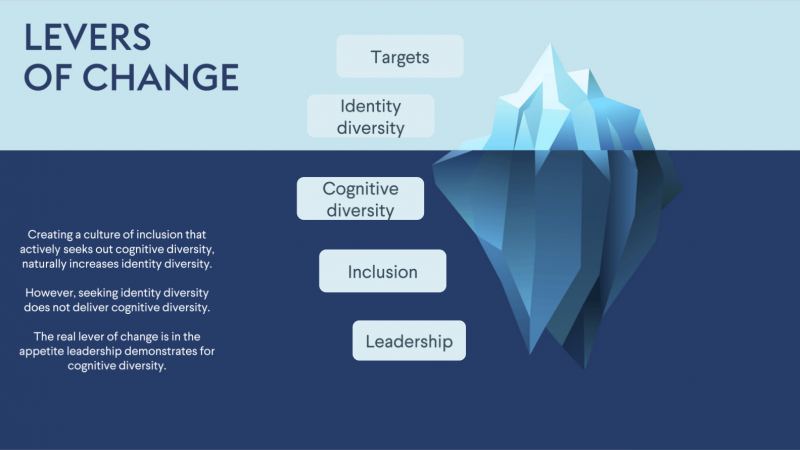In the last ten years, organisations have focused on increasing identity diversity across their workforce – that is, diversity based on people’s gender, age, ethnicity, cultural descent or sexual orientation. Boards and leadership teams have assessed their organisation’s progress on diversity by measuring the representation of different identity groups. Is this a helpful way to make progress on this important topic? It certainly has been a good first step, but we outline here why it’s not enough.
Studies show that visibly diverse teams outperform homogenous-looking groups. This is because lack of visible diversity in a team tends to generate a preference for groupthink. In a homogenous team, people want to fit in, and it becomes more important than expressing different opinions. This leads to a lack of innovation and a greater risk of making the wrong decisions. However, research also shows that identity (visible) diversity isn’t enough to deliver enhanced performance for a team or a business
For diversity initiatives to really impact a company’s bottom line, leaders need to focus on creating identity diversity AND cognitive diversity – diversity in the way people think – across their organisation. That is, leaders need to attract people who come from different career paths and study areas; individuals who bring different knowledge, expertise, areas of passion, thinking preferences and values. They also need to ensure that teams are able to leverage and value that cognitive diversity.
There’s a problem though: because cognitive diversity is so broad, it can’t be measured. But there is a good proxy to measuring cognitive diversity. By measuring inclusion, organisations can assess the extent to which they seek, value and leverage cognitive diversity. The connection between diversity, inclusion and performance follows this simple equation:
Identity diversity + cognitive diversity + inclusion = enhanced performance

How can leaders behave more inclusively?
If leaders are serious about creating a culture that’s hungry for diversity of thought, inclusion needs to be reframed. Until now, it’s been implied that leaders can achieve inclusion simply because they want it. Most leaders intend to be good, fair people, so they assume they are inclusive. But inclusion is not about being nice or fair. Rather, it is far more complex, and requires deliberate action to mitigate the exclusion that naturally takes place when humans come together.
The issue is that inclusion has not been measured in the right way. As a community, we have implied that inclusion will naturally be present if we have identity diversity. To make progress on this issue, organisations need to start defining specifically what a culture of inclusion entails.
At Serendis, we’ve spent the last five years looking at how inclusion can be accurately measured across organisations. In particular, we’ve explored what we can do to assess, measure and support leaders so they can ask themselves, and answer, these questions:
- What is likely to hinder inclusion in this situation?
- How can I consciously and deliberately take action to overcome those hindrances?
To help leaders understand how they can shift their behaviour to become more inclusive, we’ve created a framework with the nine core behaviours of highly inclusive cultures. And we’ve researched, constructed and perfected a 360-degree tool, which has been twice validated by Data Analytics Australia, to help leaders identify their current leadership strengths or areas to improve against this framework.
Organisations have already been successfully measuring identity diversity. Now, with Serendis’ nine-behaviours framework, they can also measure inclusion and bring more practical and rigorous approach to supporting their leaders in this space. With two of the three terms in the D&I equation being measurable, organisations can start making real progress.
The nine behaviours of inclusive cultures
In terms of inclusion, the approach we’ve taken at Serendis is that if leaders aren’t consciously including, then they are most probably unconsciously excluding. This isn’t a criticism: it’s human nature to be drawn to people who are similar to us. Which means that regardless of our seniority or tenure, creating a culture of inclusion goes against our instincts. Leaders must therefore consciously override their innate behaviours, and replace them with behaviours which enhance inclusivity, so that people who are different to them feel comfortable – and compelled – to contribute ideas.
While this may all sound good in theory, how do leaders consciously override their instincts? Enter Serendis Leadership’s nine behaviours.
The nine characteristics of inclusive cultures that we’ve identified fall under three pillars: personal, team and strategic behaviours. As you read through them, you can start to ask yourself: How often do I see these behaviours in my organisation? And which ones do I think will have the most impact on helping shape a more inclusive culture in my company?
Personal
- Mental Agility – a leader’s ability to challenge their perspectives and change their minds when presented with different or opposing ideas.
- Personal Awareness – a leader’s openness to recognising their personal assumptions, beliefs, and emotions, and how they impact others.
- Conviction and Drive – a leader’s proactive and explicit engagement in supporting and promoting identity and cognitive diversity in the workplace.
Team
- Cognitive Humility – a leader’s commitment to interrupting their own cognitive biases, especially when it applies to assessing talent, merit and potential.
- Transparency – delivering feedback to all team members, including those a leader feels less comfortable, or has less in common with.
- Psychological safety – leading teams in a way that actively seeks out and encourages all participants’ perspectives, contributions and experiences at all times; where challenging the status quo is not just encouraged but expected.
Strategic
- Diverse Connections – leaders demonstrate an active interest and consult a variety of stakeholders to extend beyond their own area of expertise or demographic group.
- Broaden Perspective – Leaders recognise, consider and anticipate the broader factors that directly or indirectly affect their own activity or organisation.
- Courage – leaders make changes in a volatile and uncertain environment.
A deep dive into mental agility
For each of these nine behaviours, we developed detailed situations and questions, to help leaders identify how they can act differently – how they can consciously challenge ingrained attitudes and behaviours – on a day-to-day basis. To illustrate what we mean, we’ll now take a deep dive into the first behaviour, mental agility. (To recap, mental agility is a leader’s ability to challenge their perspectives and change their minds when presented with different or opposing ideas.) While all nine behaviours are important, leaders’ mental agility is one of the most criticalfactors in the successful creation of inclusive cultures.
Here are some situations when you should be particularly aware of exercising mental agility, so you don’t exclude others:
- When you have a lot of experience in a particular area and someone with much less experience is suggesting changes to your approach.
- When the group isn’t listening to what you’re telling them and they bring up other ideas that are taking the team off track.
- When your work, which you have put much expertise, experience and energy into, is being criticised and you think others don’t understand what you’re trying to achieve.
- When a meeting includes a small number of dominant, more experienced individuals who take part in the decision-making process, resulting in some individuals not being formally invited to offer their opinion.
Here are some ways you can enhance your mental agility:
- Watch out for feeling annoyed and ask yourself: “What if there’s some truth in what they’re saying?” “What am I not seeing here?”
- Watch out for feeling the need to defend and ask yourself: “How can I understand the other person’s concerns rather than insisting they listen to me?”
- As meetings progress, ask yourself: “Have I heard from everyone in the room and/or on Teams/Zoom?”
- Before making a decision, ask yourself: “Have we invited the devil’s advocate view in this conversation and have we explored all corners of this topic? Is there a risk of group-think?”
- Acknowledge when you make mistakes.
- See all perspectives as worthwhile and watch out for a natural instinct to defend your views.
The idea is for these questions to act as prompts for leaders, encouraging them to be mindful of their daily behaviour, and to make small changes which will eventually become second-nature.
Where to from here?
Leaders’ work to shift identity diversity in workplaces has been a tremendously important first step in creating more diverse cultures. Now, we’re ready for D&I 2.0: creating real behavioural change across organisations. As leaders embark on the next leg of their D&I journey, Serendis’ nine behaviours provide a much-needed roadmap, ensuring that diversity and inclusion efforts create meaningful change which enhances company performance and positively impacts the bottom line.



